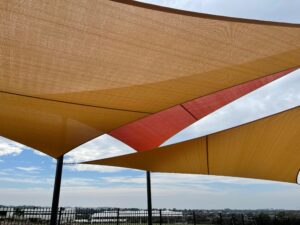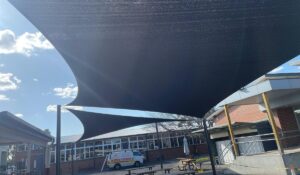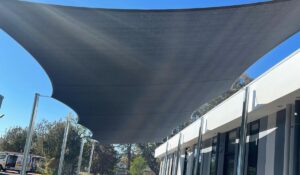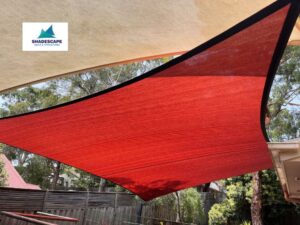Outdoor shade sails aren’t just pretty covers for play areas or lunch spots. For schools and businesses, they’re part of keeping people comfortable and safe. But here’s the thing: they need regular inspections to stay that way.
A little time spent on maintenance goes a long way in saving money, avoiding headaches and keeping things looking sharp.
Let’s talk about the five big wins that come from regular shade sail inspections. And how a professional team like Shadescape Sails and Structures can make it all super easy.
What an Inspection Covers
When the Shadescape crew checks your shade sails, they leave no bolt unturned.
Here’s what they look at:
- Anchors and supports: Posts, beams and wall fixings checked for rust, tightness and alignment.
- Fabric and seams: Watching for tears, sagging, fading or signs of wear.
- Tension and drainage: Making sure water doesn’t pool and sails stay tight.
- Surroundings: Trees, playground equipment or new obstacles that might cause trouble.
- Documentation: Photos, notes and a plan for what to fix and when.
Who should inspect: trained technician or in-house staff?
You can get your own maintenance crew to do simple walk-throughs. Spot-check for sagging sails, loose bolts or any clear damage. But for a deep check you want a trained technician. Shadescape technicians have the tools, the eye and the experience to keep your setup solid for years.
How often to inspect
Here’s a simple schedule to follow:
- Monthly: Quick visual check by in-house staff.
- Quarterly: A closer look at tension, bolts and surroundings.
- Annually: A full professional inspection with report and photos.
For schools or high-traffic areas, that yearly check is non-negotiable.
Benefit 1: Improved Safety and Reduced Liability
Safety comes first. Always. A single loose anchor or worn fabric seam can turn into a serious hazard. Regular inspections spot these issues early before anything goes wrong.
And those written reports? They’re your best friend for insurance and compliance. They prove you’ve done your due diligence.
Example: A school notices during inspection that one bracket is cracked from weather wear. Quick fix. No injuries. No chaos during lunch break.
When it comes to safety, inspections focus on:
- Anchors
- Fabric
- Tension
- Clearance from trees and equipment
Benefit 2: Lower Long-Term Maintenance and Repair Costs
Small fixes now prevent big bills later. A tiny fabric tear or a rusty bolt can be sorted out cheaply. But if you leave it, the damage spreads next thing you know, you’re replacing an entire sail.
Stay ahead with proactive maintenance. Plan minor fixes in quieter periods. Keep spare parts handy. Review your reports to budget smarter.
Example ROI: A $100 repair today can stop a $2,000 replacement tomorrow. Easy win.
Benefit 3: Longer Shade Sail Lifespan and Better ROI
Shade sails are an investment treat them that way. Inspections protect that investment by keeping everything under control.
Correct tension stops the fabric from stretching and tearing. Spotting corrosion early saves the structure. Fixing fading keeps it looking sharp and professional.
With care, your sails can last 8 to 10 years instead of just 5. That’s extra years of comfort, shade and savings.
Benefit 4: Compliance with Local Standards and Insurance Requirements
Paperwork might not be fun, but it matters.
reports prove you’re doing things right. Some insurers even reward it with better terms.
Schools often have strict maintenance requirements too. Keeping clear records shows you’re serious about safety and care.
A simple system with dates, photos and reports builds a strong maintenance history. And that’s worth its weight in gold when something unexpected happens.
Benefit 5: Optimised Performance and User Comfort
Shade sails aren’t just about looks, they’re about comfort. When sails sag, they lose shape and shade less. Inspections fix that by keeping tension tight and coverage spot on.
If the sun’s shifted or new trees have grown, an inspector can tweak positioning too.
That means better UV protection and cooler spaces.
More shade means happier students, relaxed customers and energised employees.
That’s a win for everyone.
Simple Shade Sail Inspection Checklist
Use this handy list for quick checks:
- Fabric: Tears, fading or loose seams
- Anchors: Tight, corrosion-free, aligned
- Supports: No cracks, rust or rot
- Tension: No sagging, shape holding firm
- Clearance: Trees trimmed and safe distance
- Drainage: Water runs off cleanly
- Hardware: Spare fittings available
- Hazards: No sharp edges or exposed bolts
- Photos: Full view and close-ups
- Recommendations: Immediate fixes or next review date
How to Run a Recurring Inspection Program
- Monthly: Quick in-house check
- Quarterly: Maintenance review and re-tension if needed
- Annually: Full professional inspection by Shadescape
- Record everything: Keep photos, dates and notes in a shared folder
- Budget smart: Add inspections to your yearly maintenance plan
This keeps everything easy to track and avoids nasty surprises.
FAQs
Q: How often should shade sails be professionally inspected?
At least once a year for schools and busy commercial spaces. More often if you’re near the coast or high-wind areas.
Q: Can our maintenance team handle it?
They can do visual checks, yes. But a pro inspection ensures everything’s structurally sound and fully documented.
Q: Will inspections extend our warranty?
Yes. Many warranties depend on proof of maintenance and regular inspection reports.
Q: What happens if we skip inspections?
You could end up with damaged sails, higher repair bills, safety risks or even invalid insurance.
Keep your shade sail system safe, strong and looking its best. Contact Shadescape now to book your professional inspection.
Get a detailed report, photo record and a maintenance plan that saves you money. Protect your space, your people and your budget.







